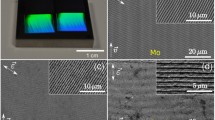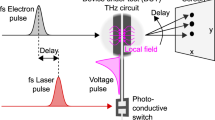Abstract
We demonstrate that picosecond ultrasonics provides detailed information on the structure and properties of patterned arrays of copper fine lines used in silicon chip interconnections. In this method, the sample surface is momentarily heated several °C using a pump laser beam, and the transient change in the optical reflectivity is measured by a probe laser beam. Measurements of the optical reflectivity are made on time scales ranging from picoseconds to nanoseconds, revealing information on electronic, acoustic and thermal properties. We have applied this method to samples consisting of copper line arrays of 0.4 µm linewidth, 0.65 µm pitch and 0.35 µm depth in SiO2 on silicon wafers. For comparison, we examined the picosecond ultrasonic response of 200 nm-thick blanket copper thin films. The patterned Cu lines are found to have long-term oscillations at frequencies of 4.39 and 8.29 GHz with lifetimes at least 10 times longer than the oscillations in the blanket Cu film. A two-dimensional mechanical analysis was developed which uses as input parameters the dimensions and sound velocities of the materials in the sample, and finds the normal mode frequencies and displacements. The main vibrational modes are identified and described for the patterned lines, and the simulations confirm that the lowest frequency modes have very small damping coefficients. Also, the time-dependent signal is shown to reveal details of interface layers and integrity of the copper/liner interface.
Similar content being viewed by others
References
C. Thomsen, H. T. Grahn, H. J. Maris, and J. Tauc, Phys. Rev. B 34, 4129 (1986).
H.-N. Lin, R. J. Stoner, and H. J. Maris, J.Non-Destructive Eval. 9, 239 (1990).
H. J. Maris, Scientific American, 278, 86 (1998).
R. J. Stoner and H. J. Maris, Future Fab International, 1, 339n (1997).
Guray Tas and Humphrey J. Maris, Phys. Rev. B 49, 15046 (1994).
“Studies of Plasticity in Thin Al Films Using Picosecond Ultrasonics”, (G.A. Antonelli and H.J. Maris), to appear in the Proceedings of the Materials Research Society Fall Meeting, Boston, 1999.
W. S. Capinski, H. J. Maris, E. Bauser, I. Silier, M. Asen-Palmer, T. Ruf, M. Cardona, and E. Gmelin, Appl. Phys. Lett. 71, 2109 (1997).
W. S. Capinski, H. J. Maris, T. Ruf, M. Cardona, K. Ploog, and D. S. Katzer, Phys. Rev. B 59, 8105 (1999).
V.E. Gusev and O. B. Wright, Phys. Rev. B 57, 2878 (1998).
G. Tas, R. J. Stoner, H. J. Maris, G. W. Rubloff, G. S. Oehrlein, and J. M. Halbout, Appl. Phys. Lett. 61, 1787 (1992).
U. Gerhardt, Phys. Rev. 172, 651 (1969).
Author information
Authors and Affiliations
Rights and permissions
About this article
Cite this article
Harper, J.M.E., Malhotra, S.G., Cabral, C. et al. Microstructural Analysis of Copper Interconnections Using Picosecond Ultrasonics. MRS Online Proceedings Library 612, 751 (2000). https://doi.org/10.1557/PROC-612-D7.5.1
Published:
DOI: https://doi.org/10.1557/PROC-612-D7.5.1




